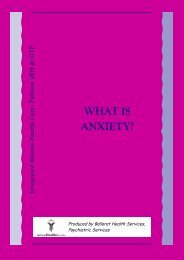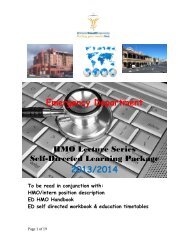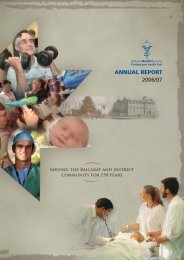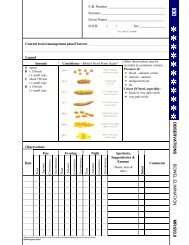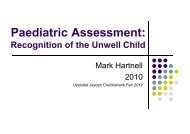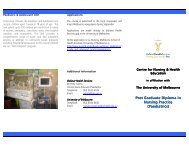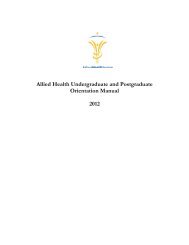Quality of Care Report - Ballarat Health Services
Quality of Care Report - Ballarat Health Services
Quality of Care Report - Ballarat Health Services
You also want an ePaper? Increase the reach of your titles
YUMPU automatically turns print PDFs into web optimized ePapers that Google loves.
Committed to SafetyBHS is committed to providing thesafest possible care and environmentfor our patients, their visitors and ourstaff. A safe environment is one inwhich risk has been reduced to anacceptable level. A risk is anythingwhich could prevent the delivery <strong>of</strong>usual business, in this case, health care.Risk management therefore is puttingprocesses and strategies in place thattry to anticipate and prevent these risksfrom occurring.<strong>Ballarat</strong>’s risk management frameworkhas expanded significantly in the pastyear as a result <strong>of</strong> the high level <strong>of</strong>commitment by the managementteam. Initiatives include:• A full time Risk Manager wasappointed in May 2008 to coordinateand oversee thedevelopment <strong>of</strong> risk managementstrategies across all the clinical andcorporate areas <strong>of</strong> the health service.• The Risk Manager is a member <strong>of</strong> theGovernance and Risk ManagementUnit to ensure that it is part <strong>of</strong> theculture and processes <strong>of</strong> qualityimprovement built up at BHS overrecent years.• A comprehensive and dynamic riskregister across all areas <strong>of</strong> the healthservice has been completed and isregularly reviewed. Staff at all levelsare able to feed into this when theyidentify risks in their local areas. Theelectronic risk register is linked to theincident reporting system to assist usto use incidents to identify risks.• The Occupational <strong>Health</strong> and Safetyteam visit all sites and units toconduct and assist staff inundertaking safety audits <strong>of</strong> theenvironment and equipment.• Executive and senior staff havereceived training from the VictorianManaged Insurance Association(VMIA) to assist them to be part <strong>of</strong>the risk management process andculture at BHS.• Training in using the Riskman database effectively is provided regularlythrough the ongoing Pr<strong>of</strong>essionalDevelopment Program.• Special training events on patientsafety and monitoring performanceare <strong>of</strong>fered to staff throughout theyear by the Governance and RiskManagement Unit.• The key clinical risk areas continue tohave active and effective HarmMinimisation Working groupsleading our improvement in the areas<strong>of</strong> infection control, falls, pressureulcers, medication errors, chokingand swallowing hazards and violenceand aggression.• We use a large range <strong>of</strong> sources tohelp us comprehensively identify ourrisks including:o Incident reports;o Clinical and operational audits;o Responding to alerts andrecommendations from otherorganisations, and the Department<strong>of</strong> Human <strong>Services</strong>, nationally andinternationally; ando Patient feedback.Managing and learning from thingsthat go wrongIncident reporting system andprocesses for ensuring the properfollow up and management <strong>of</strong> adverseevents (unplanned harm to patients orstaff) in a health service is essential togood clinical governance and riskmanagement.We do this by investigating events thathave gone wrong in order to ensure welearn the lessons and try and avoidthem happening again in the future.Integral to this is a culture <strong>of</strong> no blamewhere staff feel able to report allevents and mistakes and not cover itup.No risk <strong>of</strong> delay in emergenciesThe investigation <strong>of</strong> some incidents involving liftdelays in 2006-2007 during patient emergenciesidentified significant risks.There was a problem with a centrally locatedresuscitation trolley in the Intensive <strong>Care</strong> Unit in alarge multi-story hospital. Difficulties with the priorityaccess to the lifts to get the resuscitation equipmentand team to the patient requiring emergency care asquickly as possible was also identified.To reduce that risk in the past year there has been anupgrade <strong>of</strong> the lifts allowing the emergency team toaccess it immediately. Extra resuscitation trolleys havealso been positioned on every floor <strong>of</strong> the hospitalmaking our response time quicker in an emergencysituation. Extensive staff training has also beenundertaken.31<strong>Ballarat</strong> <strong>Health</strong> <strong>Services</strong> <strong>Quality</strong> <strong>of</strong> <strong>Care</strong> <strong>Report</strong> 2007-08



